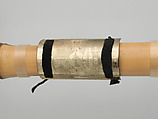Daegeum
Not on view
The daegeum is a transverse bamboo flutes with six finger holes and an additional hole covered by a membrane. This membrane produces a buzzing and gives the daegeum a nasal, buzzing timbre. The flute is used in court and vernacular music and has its origin in the Unified Silla (668-918), with its invention linked to a story with King Sinmun (r. 681-692).
Description: Cylindrical bamboo tube stopped at blowing end; elliptical blow hole, six fingerholes, vent hole, and hole covered with a reed membrane; clear nylon string wound between holes, and a rectangular plate protecting membrane hole.
Due to rights restrictions, this image cannot be enlarged, viewed at full screen, or downloaded.
This artwork is meant to be viewed from right to left. Scroll left to view more.




